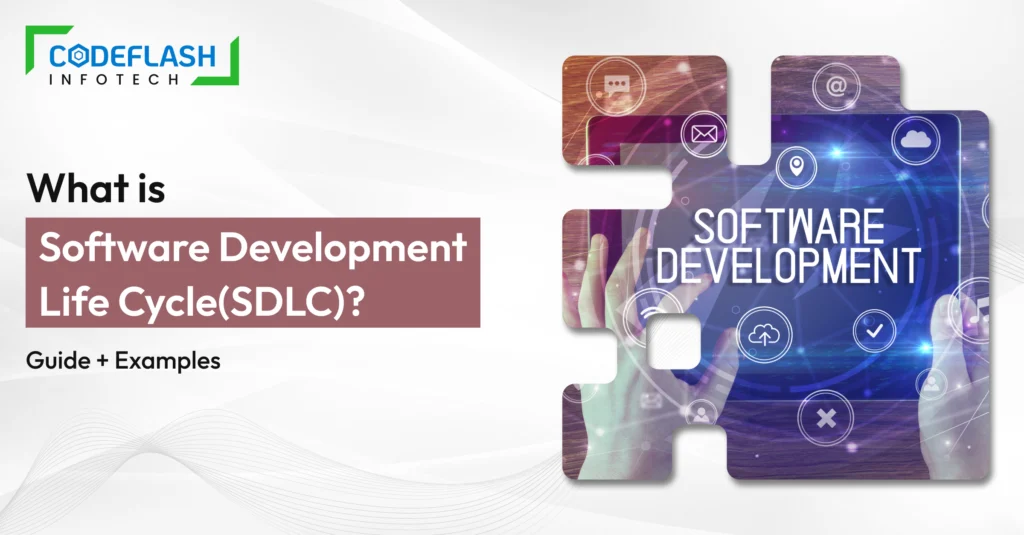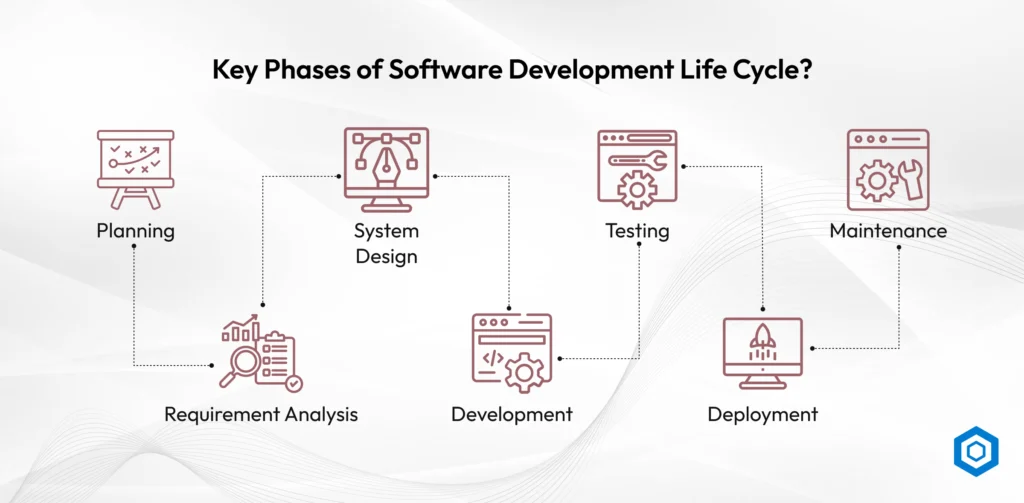
What Is Software Development Life Cycle (SDLC)? Guide + Examples
27 MAY
Software development functions through an organized sequence that develops concepts into operational applications or systems. SDLC presents a certified process through which the transformation takes place because it follows a systematic path. The market for software lifecycle development is predicted to increase at a CAGR of 11.5% from 2023 to 2030. Software development requires the SDLC to provide management control throughout its development cycle from initial concepts to deployment and post-launch maintenance.
Knowledge of the SDLC remains essential for achieving practical software delivery projects alongside schedule and cost reduction.
What is Software Development Life Cycle?
The Software Development Life Cycle (SDLC) provides a framework to sequence the entire software development process. The process contains various stages, beginning with planning and ending with analysis. Design and development follow, testing starts before deployment, and maintenance occurs. SDLC divides its process into separate phases, which provide individual aims to reduce potential dangers while managing expenses optimally and enhancing overall performance.
SDLC guarantees software delivery of products that fulfill business needs, meet industrial directives, and respect predetermined scheduling requirements.
Have an idea or project in mind? Drop us an email.

Key Phases of Software Development Life Cycle (SDLC)?
- Planning
The project determines all major areas during this phase, including its boundaries, budgets, timescale, and available resources. Project feasibility assessment follows between stakeholders and development teams while they establish project objectives together.
- Requirement Analysis
The responsibility of this phase belongs to business analysts who obtain requirements from stakeholders to define software functionality requirements. This method makes the identification process of functional and non-functional software specifications possible.
- System Design
Design and development teams create the system framework based on the specifications that have been established. The creation process for UI/UX design, database models, and system architectures occurs at this stage.
- Development
The coded development begins once developers obtain the finalized design. The project’s complexity determines its division into multiple modules, which different teams work on separately.
- Testing
The quality assurance (QA) team conducts software testing to check for performance issues and bugs and verify adherence to the initial requirements. The testing process contains three basic stages: unit testing, integration testing, and system testing.
- Deployment
Following successful tests and software approval, it transitions to operational use. Software deployment occurs step by step when handling big system implementations.
- Maintenance
The maintenance phase follows deployment since software needs continuous care. Software maintenance occurs in this phase, where security patches, new features, and updates are implemented.
Curious how we’ve helped businesses like yours succeed? Check out our portfolio for real-world examples of success stories of DevOps and software development.

SDLC Models
There are different models of the SDLC, each with its own approach to software development:
- Waterfall Model
Every stage of development needs completion to start the following phase in this linear method. The model shows optimal application in developing small projects requiring straightforward definitions and parameters.
- Agile Model
A developmental methodology based on flexible delivery with collaborative customer interaction and swift systems development. Agile works well for dynamic or complex projects.
- V-Model
This development model, which started from Waterfall, incorporates verification and validation processes into each phase of the programming stages.
- Spiral Model
Combines iterative development with systematic aspects of the Waterfall model. Ideal for large, high-risk projects.
- DevOps Model
This modern model unites development teams with operations units for higher speed and quality results in the software lifecycle.
Integrating DevOps in Software Development Life Cycle (SDLC)
What is DevOps?
Benefits of DevOps in Software Development Life Cycle (SDLC)
- Faster Time to Market: Automating builds, tests, and deployments speeds up release cycles.
- Improved Quality: Continuous integration and testing ensure early bug detection.
- Better Collaboration: DevOps encourages cross-functional teams and smoother communication.
- Scalability: DevOps practices are ideal for cloud-native applications and microservices.
- Security Integration: DevSecOps ensures security is integrated from the beginning of the development cycle.
DevOps Tools and Methodologies
Popular DevOps tools include:
- CI/CD: Jenkins, GitLab CI, CircleCI
- Configuration Management: Ansible, Chef, Puppet
- Containerization: Docker, Kubernetes
- Monitoring: Prometheus, Grafana, ELK Stack
DevOps tools and methodologies aim to automate manual processes and foster a rapid, reliable delivery culture.
Why SDLC Matters
- Risk Management
SDLC helps teams find problems in advance to enable rapid responses.
- Efficiency
The various phases operate efficiently, decreasing production costs and time-related setbacks.
- Budget Control
Project success depends on having detailed plans and exact timelines, allowing teams to maintain budget compliance.
- Quality Assurance
The outcome reaches more excellent quality standards through testing cycles and feedback operations.
- Customer Satisfaction
Establishing well-structured procedures ensures that the final product will meet the needs of the customers and business requirements
Real-world examples
- Netflix:
The combination of Agile SDLC and DevOps practices enables Netflix to provide regular updates while ensuring its platform remains highly available. Their automated deployment and monitoring systems boost their capability to deliver new features, resolve bugs, and maintain consistent user experiences for their worldwide base of millions.
- Spotify:
Spotify adopts the Agile model to concentrate on delivering continuous integration and delivery, known as CI/CD, while fulfilling its business requirements. Their staff members organize themselves into small functional groups for fast feature delivery, which lets them improve their products according to user input to maintain their music stream market position.
- Amazon:
Amazon implements a DevOps-led SDLC as the framework for its e-commerce platform support. Their microservices architecture and automation tools permit fast rollout capabilities and efficient scaling and uptime maintenance, particularly when Black Friday sales surge occurs.
How to Choose the Right Software Development Life Cycle (SDLC) Model
Choosing the right SDLC model depends on:
- Project size and complexity
- Requirements stability
- Time constraints
- Team structure and experience
- Integration needs
Agile and DevOps provide optimal results for changing projects, yet the Waterfall model delivers better functionality to smaller, straightforward projects.
Conclusion
Understanding the Software Development Life Cycle is key to building efficient, high-quality software. By incorporating DevOps tools and methodologies, teams can further streamline development, improve collaboration, and reduce time to market. Whether you’re an enterprise or a startup, using a structured SDLC framework combined with DevOps can ensure project success. And if you want to scale efficiently, don’t hesitate to hire a DevOps development company that can bridge the gap between coding and deployment. Your software initiatives can thrive in today’s fast-paced digital landscape with the right people and processes.
Ready to take the next step in your software journey? Contact us today.
Frequently Asked Questions
Benefits of DevOps include faster delivery, reduced failure rates, improved collaboration, enhanced security, and better resource utilization. It allows teams to respond quickly to changes and continuously improve the software quality.
When you hire DevOps developers, you gain access to experts who can automate deployment, manage cloud infrastructure, and enhance team collaboration. This reduces time-to-market, improves reliability, and supports scalable software growth.





